'Round the Table' Family Catechesis
Advent (8)
AIM:
1. To foster an anticipatory spirit towards the birth of Jesus.
2. To introduce Advent Wreath.
3. To introduce the role of the prophet and to announce to the child that Jesus is the light.
4. To prepare children for the coming of the child Jesus.
5. To introduce children to the history of Jesus’ presence here on earth.
MATERIALS:
Advent Wreath, The Way to Bethlehem
The Advent song can be found on youtube:
http://www.youtube.com/watch?v=L6IsKFuoM_E
ADVENT SONG:
Light one candle for hope, one bright candle for hope;
He brings hope to every heart, He comes, He comes.
Light one candle for peace, one bright candle for peace;
He brings peace to every heart, He comes, He comes.
Light one candle for joy, one bright candle for joy;
He brings joy to every heart, He comes, He comes.
Light one candle for love, one bright candle for love;
He brings love to every heart, He comes, He comes, He comes.
Light one candle for Jesus, one bright candle for Jesus;
He brings love to every heart, He comes, He comes, He comes.
WEEK ONE: Hope
Prophecy of Isaiah 9:2 and Gospel of John 8:12
For thousands of years people were waiting for the Messiah, Saviour to come. We, too, are waiting for Christmas.
Who are we waiting for?
At Christmas we will celebrate the birth of Jesus, our Saviour and the Good Shepherd.
The time of our waiting and of preparation for Christmas is called Advent.
How long do we prepare for Christmas?
There is four weeks of Advent.
Did you notice what the colour of the priest’s vestments was last Sunday and what was the colour of the candles on the Advent Wreath?
The Church has a colour for preparation time; it is purple. Last Sunday in the church we lit the first purple candle for the first week of preparation to Christmas.
During the first week we light a candle for HOPE.
Where was Jesus born? (Bethlehem)
During Advent we are all on the journey to Bethlehem.
So who will show us the way?
For many years people were hoping for Jesus to come. They all wonder who he is going to be like. Prophets – people who listen to God’s voice – told others many things about the Saviour. You can find what they said - their prophesies - in the Bible.
Prophets can show us a way.
Place the figure of the Prophet on the purple felt.

One of the prophets whose name was Isaiah said something special about who the Saviour is going to be. Isaiah lived 700 years before Jesus. Isaiah knew that Jesus is coming. He took some special words to the people because the people were very troubled. We could say that they were living in darkness.
What is darkness? When it gets dark at night, how do you feel? Is it easy to find your way in the dark? We have electricity, we don’t experience darkness very often.
Isaiah wanted to talk to these people about what it meant to be in darkness. He said something very special to them. This is called prophecy of Isaiah (It can be found in the Bible; Isaiah 9:2a):
"The people who were walking in darkness have seen a great light."
The prophet talked about a great light. What does light mean for people in darkness?
Isaiah says that the people who were walking in darkness have seen a great light. The people were waiting for someone to come. Who they were waiting for? Could Jesus be the light for us? One time Jesus said (It can be found in the Bible; John 8: 12):
"I am the light of the world. Whoever follows me will never walk
in darkness, but will have the light of life."
Isaiah’s words were not just for the people of Israel. They are for us, today. Now we are waiting for that light.
Responding to God’s Word:
I wonder how the prophets listened to God?...
I wonder how they knew it was God who spoke? ...
I wonder if there are still prophets today who can show us the way to Bethlehem?
I wonder what the way to Bethlehem is like?
What kind of light do we know?
What does light do for us?
What is HOPE?
Who/What is this light for whom the people waited for such a long time?
Who are we waiting for in Advent?
Invite children to draw in response to what they have heard. They may draw the Advent Wreath with one purple candle, Isaiah, write HOPE and place the drawing under the way to Bethlehem beneath Isaiah.
Other Prophecies for the future years...
- Prophecy of the Names Isaiah 9:6
“For to us a child is born, to us a son is given, and the government will be upon his shoulders. And his name will be called Wonderful, Counsellor, Mighty God, Everlasting Father, Prince of Peace.”
Who is the special child? What do each of these names mean?
Wonderful Counsellor – wise and just
Mighty God – power and strength
Everlasting Father – unconditional love forever
Prince of Peace – giver of the gift of peace
The various names for the Messiah provide your child with language for prayer.
- Prophecy of Mother Isaiah 7:14
“Behold, a young women shall conceive and bear a son and shall call his name Emmanuel”.
Explore meaning of Emmanuel: God is with us. How is God with us?
- Prophecy of Bethlehem Micah 5:2
“But you, Bethlehem – Ephratathah, too small to be among the clans of Judah, from you shall come forth for me One who is to be ruler in Israel.”
Explain terms: “clans of Judah”, “ruler of Israel”, “Bethlehem-small town”
Highlight the ‘small’ – ‘great’ contrast: What is extraordinary is that the ‘great’ comes from the ‘small’.
- Prophecy of the Star and the Sceptre Numbers 24:17
“The Star shall come forth out of Jacob, and a sceptre shall rise out of Israel”.
Explore the image of kingship: Who uses a sceptre? What kind of King would Jesus be? What would his kingdom be like?
Highlight the ‘small’ – ‘great’ contrast: How big is Israel? How powerful? Yet from this tiny, powerless country comes a mighty king of peace and light.
WEEK TWO: Peace
Annunciation, Luke 1:26-38
DOCTRINAL POINTS:
- The Angel announces to Mary that she will bear the Son of God.
- Mary’s response
AIM:
- To introduce children to the history of Jesus’ presence here on earth
- To expand children’s prayer
- introduce Hail Mary - To prepare children for the following infancy narratives
INDIRECT AIM:
- To deepen the meaning of Advent
- All things are possible with God
- The power of the Holy Spirit
MATERIALS:
Advent Wreath, The Way to Bethlehem, Map of Israel
During the second week we light a candle for HOPE and for PEACE.
We are all on the journey to Bethlehem.
So who will show us the way?
Mary and Joseph can show us a way.
Place figures of Mary, Joseph and a donkey on the purple felt.

Tell the story of the Annunciation in your own words remaining faithful to the text:
Over two thousand year ago, in the town of Galilee called Nazareth, lived Mary (Find Nazareth on the map of Israel). Mary, who loved God very much, was engaged to Joseph. Joseph was from the House of David, which means that Joseph’s great, great, great...grandfather was David. David was the famous and very much loved and respected king, who loved God and who lived over 1000 years before the birth of Jesus.
One day the angel Gabriel came to Mary. He said: “Greetings, most favoured one, do not be afraid. You will have a baby, you must call him Jesus”. The Angel also told her that He would be a very special baby. He would be great, and his kingdom would last forever and ever.
Mary asked how she would have a baby since she is not married yet. The angel told her that the Holy Spirit will come upon her and she will be covered with the power of God and that her child would be called the Son of God.
He also told her that her cousin Elizabeth who has no children in her old age will have a baby, because “nothing is impossible to God”.
Mary answer the Angel that she would be obedient to God and that she wanted to do as God wished. And the Angel left.
Read Luke 1:26-38
Responding to God’s Word:
What would it feel like to have an angel visit you?
How did Mary feel?
Who is Jesus?
How was he described by the Angel?
What did the Angel say when Mary was afraid?
How did Mary answer the Angel?
How would you answer the Angel?
What is PEACE?
Invite children to draw in response to what they have heard. They may draw the Advent Wreath with two purple candles, Mary and Joseph and the donkey, write PEACE and place the drawing under the way to Bethlehem beneath Mary and Joseph and the donkey.
Teach children the first part of the Hail Mary.
For parents:
Catechism of the Catholic Church 2676:
http://www.vatican.va/archive/ccc_css/ archive/catechism/p4s1c2a2.htm
Hail Mary [or Rejoice, Mary]: the greeting of the angel Gabriel opens this prayer. It is God himself who, through his angel as intermediary, greets Mary. Our prayer dares to take up this greeting to Mary with the regard God had for the lowliness of his humble servant and to exult in the joy he finds in her.30
Full of grace, the Lord is with thee: These two phrases of the angel's greeting shed light on one another. Mary is full of grace because the Lord is with her. The grace with which she is filled is the presence of him who is the source of all grace. "Rejoice . . . O Daughter of Jerusalem . . . the Lord your God is in your midst."31 Mary, in whom the Lord himself has just made his dwelling, is the daughter of Zion in person, the ark of the covenant, the place where the glory of the Lord dwells. She is "the dwelling of God . . . with men."32 Full of grace, Mary is wholly given over to him who has come to dwell in her and whom she is about to give to the world.
Blessed art thou among women and blessed is the fruit of thy womb, Jesus. After the angel's greeting, we make Elizabeth's greeting our own. "Filled with the Holy Spirit," Elizabeth is the first in the long succession of generations who have called Mary "blessed."33 "Blessed is she who believed. . . . "34 Mary is "blessed among women" because she believed in the fulfilment of the Lord's word. Abraham. because of his faith, became a blessing for all the nations of the earth.35 Mary, because of her faith, became the mother of believers, through whom all nations of the earth receive him who is God's own blessing: Jesus, the "fruit of thy womb."
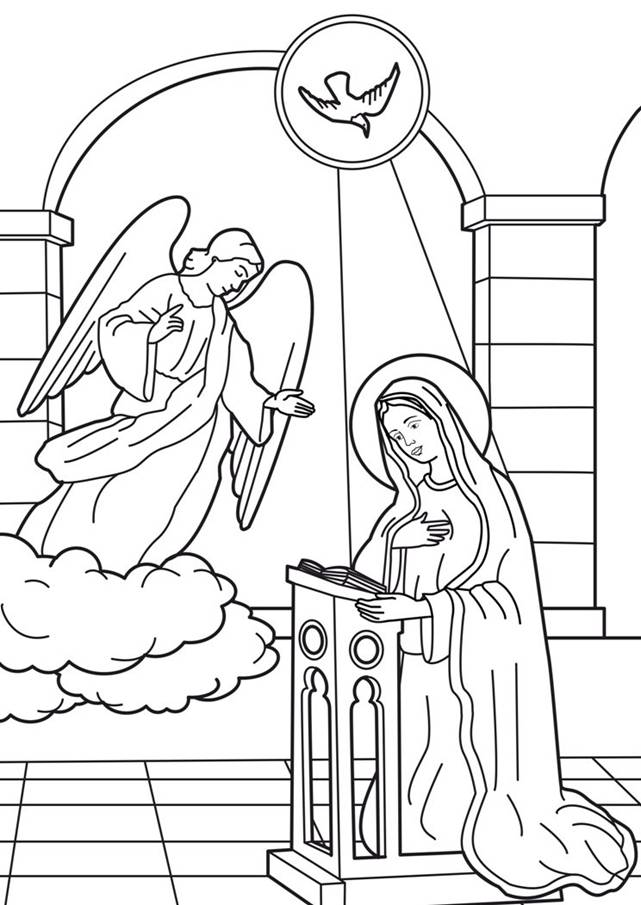

WEEK THREE: Joy
The Nativity and the Adoration of the Shepherds, Luke 2: 1-20
DOCTRINAL POINTS:
- Proclamation of the birth of Jesus Christ our Saviour, joining the transcendent and the ordinary (divine and human)
AIM:
- To announce the birth of Jesus
- To help the children to see both transcendent and the ordinary elements in the narrative.
- To expand children’s prayer - introduce “Gloria”
INDIRECT AIM:
- To prepare for and understand the liturgical celebration of Christmas
- To help children know the life of Christ
MATERIALS:
Advent Wreath, Map of Israel, The Way to Bethlehem
During the third week we light a candle for HOPE, PEACE and pink a candle for JOY.
We are all on the journey to Bethlehem.
So who will show us the way?
Shepherds and their sheep can show us a way.
Place figures of Shepherd with sheep on the purple felt.

Briefly remind children of the prophesy from Isaiah about the coming of light into the darkness; remind children of the Annunciation narrative and of the location of Nazareth and Bethlehem from the geography of Israel.
Tell the story of Jesus’ birth and the adoration of the shepherds in Luke 2:1-20 in your own words. Explain terms such as census, swaddling clothes and manger.
At this time, Israel where Mary and Joseph lived was part of the Roman Empire. The Roman Emperor Augustus wanted to have a list of all the people in the empire, to make sure they paid their taxes. He ordered everyone to return to the town where their families originally came from, and enter their names in a register (or census) there. Mary and Joseph travelled a long way (about 70 miles or 110km) from Nazareth to Bethlehem, because that is where Joseph's family came from. Most people walked but some lucky people had a donkey to help carry the goods needed for the journey. Joseph and Mary travelled very slowly because Mary's baby was due to be born soon.
When they reached Bethlehem they had problems finding somewhere to stay. So many people had come to register their names in the census, that all living quarters were taken. The only shelter that they could find was a stable or cave with the animals. In this poor place Mary gave birth to Jesus, the Son of God. In those days it was the custom to wrap newborn babies tightly in a long cloth called 'swaddling clothes'. Jesus' bed was the manger that the animals ate their hay from.
In the hills and fields outside Bethlehem, shepherds looked after their sheep through the long night. As the new day began, suddenly an angel appeared before them and the glory of God shone around them. The shepherds were very, very scared, but the angel said, 'Don't be afraid. I have good news for you and everyone. Today in Bethlehem a Saviour has been born for you. You will find the baby lying in a manger'.
Then many more angels appeared, lighting up the sky. The shepherds heard them praising God singing:
'Glory to God in highest, and on earth peace to people of good will.'
When the angels had gone the shepherds said to one another, 'Let's go to Bethlehem to see what has happened.' So the shepherds went to Bethlehem and found Mary and Joseph. The baby Jesus was lying in a manger as they had been told. When they saw him, they told everyone what the angel had said and everyone who heard the story was astonished. Then the shepherds returned to their sheep, praising God for sending his Son to be their Saviour.
Read Luke 2:1-20
RESPONDING TO GOD’S WORD:
What did the angel said to the shepherds?
How did the shepherds feel when the angel spoke to them?
What did the angel call the baby? What was special about him?
Why do you think the angel came to the shepherds in the field to make their announcement?
What did the shepherds do? Did they find the baby?
What do you think they said to Mary and Jesus?
Is there anything you would like to say to Jesus?
What do you think about Jesus being a king but being born in a manger /stable? Are kings usually born in a stable?
What do you think Mary was thinking about?
What did the shepherds do when they left the manger?
Do you think anyone listen to their great news?
Invite children to prayer or song Away in a Manger
http://www.youtube.com/watch?v=HuF-D7eaars
or O Come All Ye Faithful
http://www.youtube.com/watch?v=I2FnqoPxNbk
Invite children to draw in response to what they have heard. They may draw the Advent Wreath with two purple and one pink candles, shepherds with the sheep, write JOY, and place the drawing under the way to Bethlehem beneath shepherd and sheep. They may draw the host of angels singing Gloria…
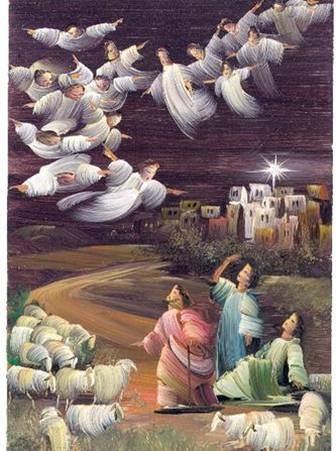
The words of the angels “Glory to God in the highest” became the prayer we say or sing during the Mass. Children will recite this prayer on the altar steps during the Christmas Eve Mass.
Please read this prayer with children a few times:
Glory to God in the highest, and on earth peace to people of good will.
We praise you, we bless you we adore you, we glorify you, we give you thanks for your great glory,
Lord God, heavenly King, O God, almighty Father.
Lord Jesus Christ, Only Begotten Son,
Lord God, Lamb of God, Son of the Father,
you take away the sins of the world,
have mercy on us;
you take away the sins of the world,
receive our prayer;
you are seated at the right hand of the Father,
have mercy on us.
For you alone are the Holy One,
you alone are the Lord,
you alone are the Most High,
Jesus Christ,
with the Holy Spirit,
in the glory of God the Father.
Amen
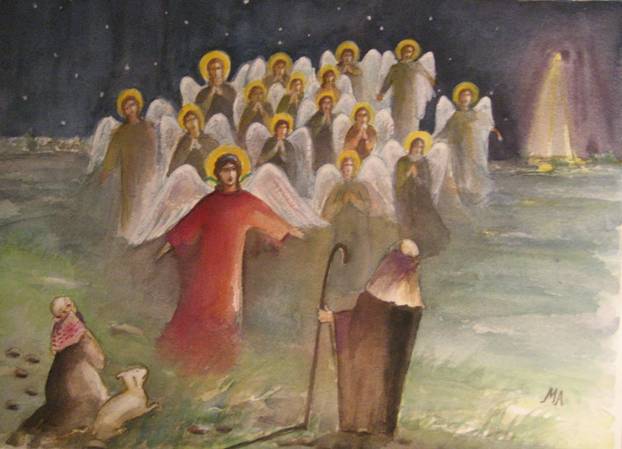
WEEK FOUR: Love
The Adoration of the Wise Men, Matthew 2:1-12
DOCTRINAL POINTS:
- Jesus is a gift to all people, rich and poor.
AIM:
- The significance of the story of the Three Wise Men
- The symbolism of their gifts.
INDIRECT AIM:
- To help children know the life of Christ.
- Why do people give presents at Christmas.
MATERIALS:
Advent Wreath, The Way to Bethlehem, Bible
During the third week we light purple candles for HOPE and PEACE, a pink candle for JOY and a purple candle for LOVE. (In the evening of 24 December we can light a white candle for Jesus and remove other candles).
We are all on the journey to Bethlehem.
So who will show us the way?
Three Wise Men and their camel can show us a way.
Place figures of the Three Wise Men and a camel.

When Jesus was born, a brand new bright star appeared in sky. Some Wise Men in faraway countries saw the star and guessed what it meant. They were very clever men that studied the stars and had read in very old writings that a new star would appear when a great king was born. They set out to find the new king and bring him gifts.
The Wise Men followed the star towards the country of Judea and when they got to Jerusalem they began to ask people: 'Where is the child who is born to be king of the Jews?' Herod, the king of Judea, heard this and it made him very angry to think that someone might be going to take his place as king. Herod sent for the Wise Men to come to him. He told them to go on following the star until they had found the baby king. He said: 'When you have found him, let me know where he is, so that I can go and worship him.’ There is a special word in scripture. The word is ‘homage’. It means to worship or adore. But Herod did not tell them that he really had an evil plan in mind to kill the new king.
Prophet Micah who lived 700 years before Jesus said that the Messiah will be born in Bethlehem. So the Wise Men followed the star towards Bethlehem. It seemed to stop and shine directly down upon the place where Jesus was.
The Wise Men entered the house and found Jesus with Mary, they bowed down and worshipped him. The Wise Men spread the gifts they had brought before Jesus.
The gifts were:
- gold – a valuable gift given to kings,
- frankincense – which is burnt in offering to God
- myrrh – special oil used to anoint people when they died.
The Wise Men were warned in a dream, by God, not to go back to Herod. So they returned home to their countries in the East by a different way.
Read Matthew 2:1-12
RESPONDING TO GOD’S WORD:
Do you think that the wise men expected to find a king in a stable?
Where a king might live?
How would a king dress?
Instead of a palace and a king wearing a crown, they found a baby in a stable. How did they recognize him to be a king?
Did they give him the gifts of a king even though he did not look like a king or dress like a king?
Who came first to give him homage?
Where the shepherds rich or poor?
What kind of people were the wise men, rich or poor? Jesus came to all people.
If you would take a gift to the baby Jesus, what would it be?
Invite children to prayer or song We Three Kings.
Invite children to draw in response to what they have heard.
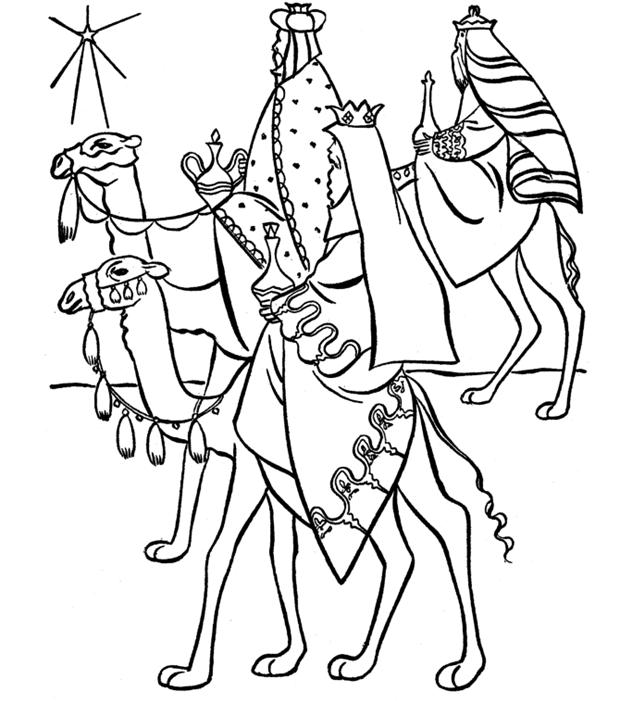
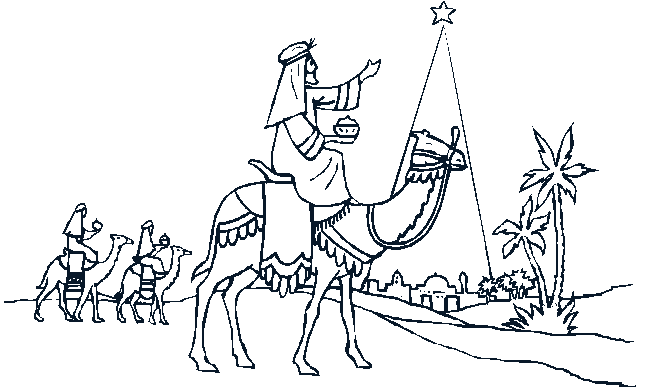

 English
English  Polski
Polski